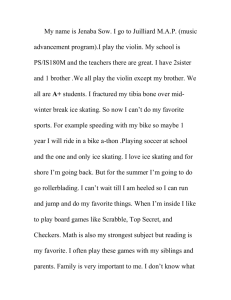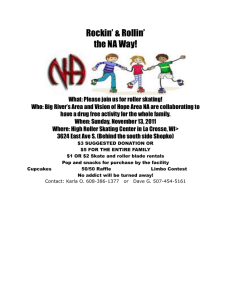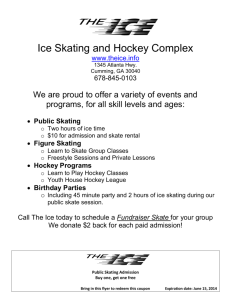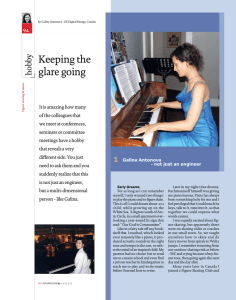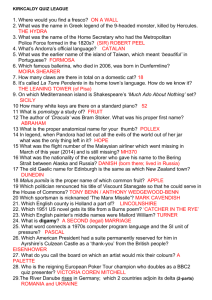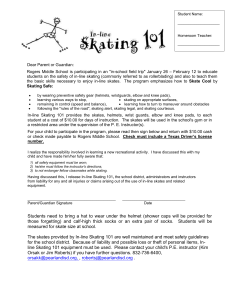Introductory Question
advertisement
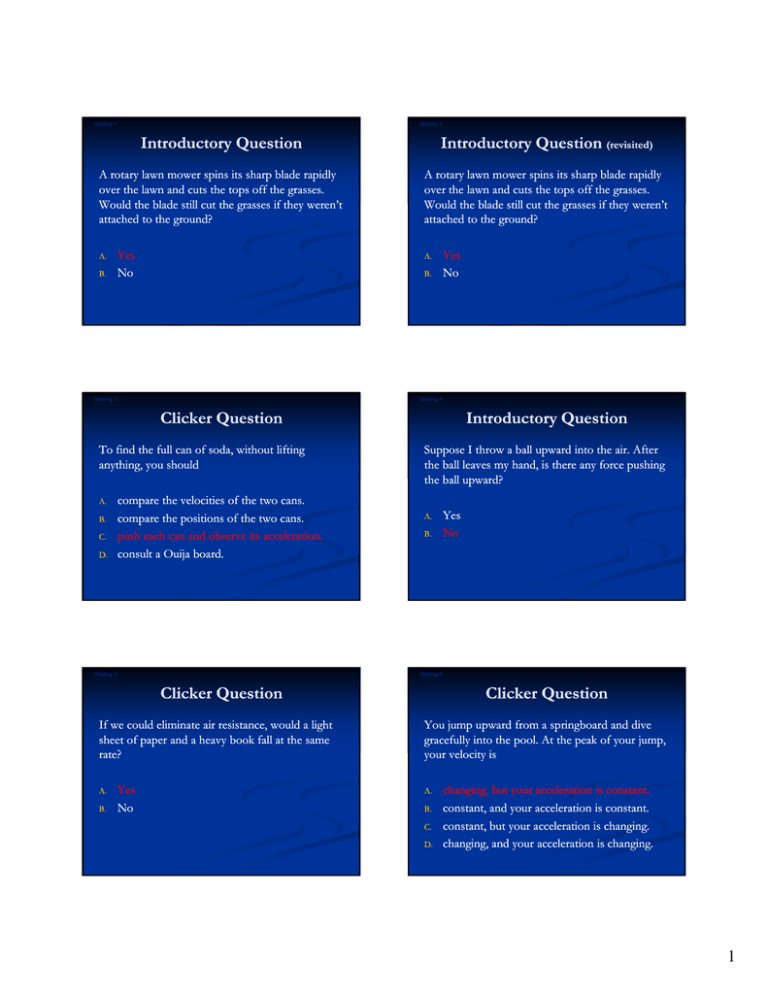
Skating 1 Skating 2 Introductory Question Introductory Question (revisited) A rotary lawn mower spins its sharp blade rapidly over the lawn and cuts the tops off the grasses. Would the blade still cut the grasses if they weren’t attached to the ground? A rotary lawn mower spins its sharp blade rapidly over the lawn and cuts the tops off the grasses. Would the blade still cut the grasses if they weren’t attached to the ground? A. B. Yes No A. B. Skating 3 Yes No Skating 4 Clicker Question To find the full can of soda, without lifting anything, you should A. B. C. D. compare the h velocities l i i off the h two cans. compare the positions of the two cans. push each can and observe its acceleration. consult a Ouija board. Skating 5 Introductory Question Suppose I throw a ball upward into the air. After the ball leaves my hand, is there any force pushing the ball upward? A. B. Skating 6 Clicker Question If we could eliminate air resistance, would a light sheet of paper and a heavy book fall at the same rate? A. B. Yes No Yes No Clicker Question You jump upward from a springboard and dive gracefully into the pool. At the peak of your jump, your velocity is A. B. C. D. changing, but your acceleration is constant. constant, and your acceleration is constant. constant, but your acceleration is changing. changing, and your acceleration is changing. 1 Skating 7 Skating 8 Introductory Question (revisited) Suppose I throw a ball upward into the air. After the ball leaves my hand, is there any force pushing the ball upward? Introductory Question Can a ball ever push downward on a table with a force greater than the ball’s weight? A. Yes No A. B. B. Skating 9 Y Yes No Skating 10 Reading Question 1.3a Reading Question 1.3b When a piano is resting motionless on the sidewalk, the net force on the piano is When you push on a cart, you do work on that cart A. A. B. C. D. equall to the h upward d support fforce on the h piano. i equal to the piano’s downward weight. equal to half the piano’s downward weight. zero.. zero Skating 11 B. C. D. E. Skating 12 Clicker Question If you push on a friend, will that friend always push back on you? A. B. Y Yes No only if it is stationary. only l if it i is i moving i in i the h di direction i off your push. h only if it is moving perpendicular to your push. only if it is moving opposite your push. regardless of its motion. Clicker Question If you push on a friend who is moving away from you, how will the force you exert on your friend compare to the force your friend exerts on you? A. B. C. You push harder Your friend pushes harder The forces are equal in magnitude 2 Skating 13 Skating 14 Introductory Question (revisited) Can a ball ever push downward on a table with a force greater than the ball’s weight? A. B. Y Yes No Clicker Question When I drop an egg on the table, it will break. What will break the egg? A. B. C. D. Skating 15 Th egg’s The ’ inertia. i i The egg’s weight. The table’s support force on the egg. The earth’s gravitational force on the egg. Skating 16 Clicker Question If I pull uphill on the cart just hard enough to balance the downhill ramp force, the cart will A. B. b motionless. be i l have a constant velocity, which may be zero. Introductory Question You and a child half your height lean out over the edge of a pool at the same angle. If you both let go simultaneously, who will tip over faster and hit the water first? A. B. Skating 17 You The small child Skating 18 Reading Question 2.1a Reading Question 2.1b When you spin a smooth stone on a slippery table, the stone naturally pivots about its When a wind turbine is completely free of external torques, it A. B. C. D. center off mass. center of gravity. rotational mass. torque. A. B. C. D. i horizontal is h i l and d motionless. i l can be horizontal or tilted, but it is motionless. has a constant angular velocity, possibly zero. has a constant angular acceleration. 3 Skating 19 Skating 20 Clicker Question To make MiniMini-Me undergo clockwise angular acceleration, I should knock A. B. C. D. the h top off hi his h head d toward d hi his ffeet. the side of his head toward your right. the middle of his body toward your right. the side of his feet toward your right. Clicker Question When a student strikes the right side of this balanced bar with a mallet, the bar will undergo tremendous clockwise angular acceleration. The egg will break A. B. C. Skating 21 while it is accelerating upward on the bar. when it hits the ground after its flight. in midair. Skating 22 Introductory Question (revisited) You and a child half your height lean out over the edge of a pool at the same angle. If you both let go simultaneously, who will tip over faster and hit the water first? A. B. You The small child Skating 23 Introductory Question The light turns green and you’re in a hurry. Will your car accelerate faster if you skid your wheels and “burn rubber” or if you just barely avoid skidding your wheels? A. B. Skating 24 Reading Question 2.2a I am pushing a file cabinet to your right along a level floor. In which direction does the floor’s frictional force on the file cabinet act? Reading Question 2.2b Which types of friction waste ordered energy (work) as disordered energy (thermal energy)? A. A. B. C. D. Skid your wheels Barely avoid skidding Toward your left. Upward and toward your left (at an angle). Toward your right. Upward and toward your right (at an angle). B. C. D. S i friction Static f i i but b not sliding lidi friction fi i Sliding friction but not static friction Both static friction and sliding friction Neither static friction nor sliding friction 4 Skating 25 Skating 26 Clicker Question A. B. C. D. E. When a block skids to a stop on a motionless desk, what work is done by those two objects? Th desk The d k does d negative i workk on the h block. bl k The block does positive work on the desk. Both objects do positive work on one another. Both objects do negative work on one another. The block does positive work on the desk, the desk does negative work on the block. Skating 27 Clicker Question A. B. C. D. E. When you pull a wheeled cart forward and it is accelerating forward, what frictional force does the ground exert on the wheels as they roll? A sliding frictional force that points backward. A static frictional force that points forward. A static frictional force that points backward. A sliding frictional force that points forward. Zero frictional force. Skating 28 Introductory Question (revisited) The light turns green and you’re in a hurry. Will your car accelerate faster if you skid your wheels and “burn rubber” or if you just barely avoid skidding your wheels? A. B. Skid your wheels Barely avoid skidding Introductory Question You are riding on the edge of a spinning playground merrymerry-go go--round. If you pull yourself to the center of the merrymerry-go go--round, what will happen to its rotation? A. B. C. Skating 29 It will spin faster. It will spin slower. It will spin at the same rate. Skating 30 Reading Question 2.3a Your momentum is equal to A. B. C. D. your weight times your velocity. your weight times your speed. your mass times your velocity. your mass times your speed. Reading Question 2.3b Can you transfer momentum to a rigid, immovable wall? A. B. Y Yes No 5 Skating 31 Skating 32 Clicker Question Introductory Question (revisited) You pound on a nail with two different mallets, one softer than the other. Their masses are equal and you swing them equally fast. Compared to the harder mallet, mallet, the momentum transferred by the softer mallet to the nail is A. the same and it exerts the same force. B. the same, but it exerts a smaller force. C. less, but it exerts the same force. D. less and it exerts a smaller force. You are riding on the edge of a spinning playground merrymerry-go go--round. If you pull yourself to the center of the merrymerry-go go--round, what will happen to its rotation? Skating 33 A. B. C. It will spin faster. It will spin slower. It will spin at the same rate. Skating 34 Introductory Question A diver stands motionless at the end of a spring board, which bends downward. If her identical twin joins her, how far downward will the board then bend? A. B. C. The same amount. Twice as far. Four times as far. Skating 35 Reading Question 3.1a An object that is in equilibrium is A. B. C. D. Skating 36 Reading Question 3.1b The force a spring exerts on one of its ends is proportional to A. B. C. D. accelerating opposite its velocity. accelerating at a constant rate. motionless. motionless or moving at constant velocity. i weight. its i h its mass. its distortion away from equilibrium. its length. Introductory Question (revisited) A diver stands motionless at the end of a spring board, which bends downward. If her identical twin joins her, how far downward will the board then bend? A. B. C. The same amount. Twice as far. Four times as far. 6 Skating 37 Skating 38 Clicker Question Introductory Question You are standing on a bathroom scale in an elevator. As the elevator starts moving upward, the scale reads If you place a tennis ball on a basketball and drop this stack on the ground, how high will the tennis ball bounce? A. B. C. your weight. more than your weight. less than your weight. Skating 39 A. B. C. To approximately its original height Much higher than its original height Much less than its original height Skating 40 Reading Question 3.2a A “bouncy” or “lively” ball bounces higher from a rigid, immovable surface than a “dead” ball does because the “bouncy” ball Reading Question 3.2b When a baseball bounces from a moving bat, the final speed of the baseball A. A. B. C. D. pushes harder on the surface. transfers less energy to the surface. returns more collision energy as rebound energy. obtains more rebound energy from the surface. Skating 41 B. C. D. Skating 42 Clicker Question When a soft, elastic ball drops onto a rigid floor, which object(s) has significant work done on its surface, as viewed from the perspective of that object’s object s center of mass? Clicker Question If a ball’s coefficient of restitution is 0.5 and it drops onto a rigid floor, how high will it bounce, relative to the height from which it dropped? A. A. B. C. i between is b the h iinitial i i l speeds d off b bat and db baseball. b ll is equal to the initial speed of the baseball. can exceed the initial speed of either object. is less than the initial speed of either object. The ball only. The floor only. Both the ball and floor. B. C. 100% of the drop height. 50% of the drop height. 25% of the drop height. 7 Skating 43 Skating 44 Clicker Question Two cars are traveling at 60 mph and 50 mph, respectively, according to a pedestrian. When they collide, their approaching speed will be A. B. C. D. 110 mph. between 50 mph and 60 mph. between 10 mph and 110 mph. between 0 mph and 60 mph. Skating 45 Clicker Question Two cars are traveling at 60 mph and 50 mph, respectively, according to a pedestrian. The range of possible collision energies for these two cars extends over a factor of A. B. C. D. 5/6. 6/5. 10. 121. Skating 46 Introductory Question (revisited) Introductory Question If you place a tennis ball on a basketball and drop this stack on the ground, how high will the tennis ball bounce? You are a passenger in a car that is turning left and you find yourself thrown against the door to your right. Is there a force pushing you toward the door? A. B. C. To approximately its original height Much higher than its original height Much less than its original height Skating 47 A. B. Skating 48 Reading Question 3.3a When you are riding a carousel that is turning at a steady rate, your acceleration is Reading Question 3.3b When you are in free fall, your apparent weight is A. A. B. C. D. Yes No f forward d (in (i the h direction di i off your velocity). l i ) toward the center of the carousel. away from the center of the carousel. zero. B. C. downward and equal to your weight. upward and equal in amount to your weight. zero. 8 Skating 49 Skating 50 Introductory Question (revisited) Clicker Question You are a passenger in a car that is turning left and you find yourself thrown against the door to your right. Is there a force pushing you toward the door? A dropped ball accelerates downward at the acceleration due to gravity. If you push downward on a ball with your open palm, it will accelerate downward A. B. Yes No A. B. C. at the acceleration due to gravity. faster than the acceleration due to gravity. slower than the acceleration due to gravity. Skating 51 Clicker Question As you push downward on a ball with your open palm, it A. B. accelerates l with i h your palm l and d pushes h upward d on your palm. accelerates faster than your palm and does not push upward on your palm. 9
